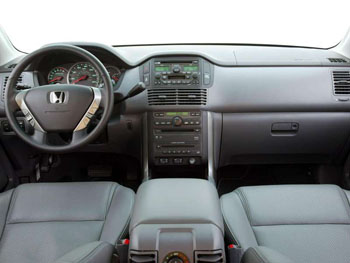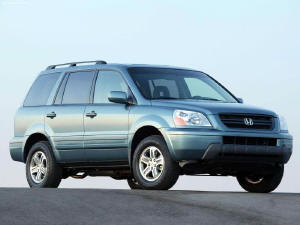After Honda tested the SUV waters with its small,
Civic based CRV sport utility in the late nineties, its next logical
step was to go after the large--and lucrative--mid-size SUV market
dominated by Ford's Explorer and Toyota's 4Runner and Highlander. Like
the Highlander, Honda went for a car-like unit body construction and
underpinnings rather than the more rugged and capable body on frame
construction of the Explorer and 4Runner. It was well thought out and
was an instant hit.
While its "crossover" design couldn't haul or tow anything near the
4Runner or Explorer, for everyday use it drove better, rode better and
was more efficient than either. Ultimately, this approach would be
adopted by everyone. Indeed, even the Explorer eventually conceded and
was re-engineered for the 2011 model year using the more car-like
design approach.
Honda likes to keep its model lines and trim
designations simple, and the Pilot was no exception. The entry level
LX and upscale EX trims were the only choices for buyers. The LX was
equipped with air conditioning, seating for eight, ABS brakes and
power windows and locks. The upscale EX boasted alloy wheels, keyless
entry, auto climate control, power drivers seat, and a better stereo.
EX exclusive options included leather upholstery, DVD entertainment
system, and a navigation system. There were no factory options for the
LX, although high-profit dealer installed options were pushed with
vigor.
At first, all Pilots featured full-time all-wheel drive and were
powered by a 3.5L sohc V6 with 240hp, backed by a 5-speed automatic
transmission. For 2005, the engine got a reported 15hp power boost,
only to see it drop the following year to 244hp. In 2006, both models
could be ordered with front-wheel drive
The Pilot comes is trim on the outside, about the same in length as an
Accord of the period with about 5 inches more in width. The styling is
conservative, and the Pilot is clearly a case of maximizing function
and then covering it with something presentable.
During the model run It received only minor design changes, most
significant being revised front fascia with projector headlights and
silver accented taillights in 2006. In customary Honda fashion, the
last year (2008) brought two new models, the VP (replacing the LX) and
a new, top of the line SE. The SE boasted a factory installed power
sunroof and DVD entertainment system as standard equipment.
 Inside, the Pilot checks off all the boxes,
but if you want luxury Honda made it clear you buy Acura.
Inside, the Pilot checks off all the boxes,
but if you want luxury Honda made it clear you buy Acura.
The Pilot's interior is pleasant, but it won't be mistaken for a
luxury SUV. There is a lot of plastic, and most come with cloth seats.
The industry's ubiquitous fake wood is nowhere to be found, and
leather seats were not even available on the LX. Up until a few years
ago, Honda was very rigid in segmenting its vehicles--if you wanted
luxury, you'd buy an Acura. In this case, it would be the MDX a
vehicle that shares the Pilot's platform. That hard line has softened
today in response to market pressures. The instrument panel features a
large speedometer with a smaller tachometer on the left and
temperature and fuel gauge on the right. The center console between
the two bucket seats is large with useful storage.
The Pilot is technically an 8-passenger vehicle, but if all those
passengers are adults it's going to be a very long ride. The Pilot
does best with four adults, and gets a passing grade with five (with
three in the middle seat). The third seat is best reserved for kids,
but two adults can squeeze in for short hops across town. Leg room is
good front and middle, dismal in the rear. You can snub your nose up
at the gas guzzling Suburbans of the world, but comfort for eight
requires size.
The only engine in the Pilot was a 3.5L sohc V6 with 240hp. Power was
bumped to 255hp in 2005, only to fall to 244hp for the rest of the
model run. It's smooth and powerful enough to move the Pilot around
without effort in most situations, feeling strained only when fully
loaded, pulling a trailer or under full acceleration. Towing capacity
is 4500lbs.
There is only one transmission, a 5-speed automatic, driving the front
wheels (2005-up) or a smart all wheel drive system. The AWD system
does not offer a low range and operates most of the time in front
wheel drive. A computer senses wheel slippage and diverts power where
needed. It can be locked in four-wheel drive mode by a switch on the
dash.
The Pilot rides and drives very well for an SUV, truly delivering on
the car-like driving experience. The suspension is soft but
controlled. Some harshness can be felt over large, sudden bumps, and
road noise is noticeable. It's no Jeep Wrangler, but it will go
anywhere off-road a sane person would venture.
Official fuel economy numbers are good, but real-world experience from
owners is not nearly as satisfying. The Pilot is, after all, a heavy
vehicle and most spend their day in in suburban and urban settings in
stop and go traffic.
Other than a major transmission problem, the Pilot has garnered an
excellent reliability history. But the transmission issue is a big
one, affecting over 1 million Hondas (not just Pilots). In the past,
Honda has in some cases discounted the $4,000+ repair by 25 or 50
percent, even if the VIN number of the vehicle wasn't specifically in
the recall program. But that's likely off the table now. Make sure to
ask if the transmission has be replaced or rebuilt, and by whom.
Here
are all the Pilot recalls. (Recall ID # 04V176000, April 15th,
2004)
Despite this, Honda consistently scores above average in the
VMR Reliability Survey.
Four wheel disc brakes with ABS were standard on all Pilots. A
standard stability control system was added in 2005. Front driver and
passenger airbags were augmented in 2006 by side curtain bags for
front and middle passengers. The Pilot scored exceptionally well in
NHSTA crash tests, with five stars for all impacts except rollover,
for which it received a four stars.
Pilots command premium money in the used car market, and there are
plenty of alternatives for you to consider. But it is so well balanced
and serves its mission so well, that you'd be remiss not to take a
test drive.
 Values
Resources
How to Use
Exotics
Classic
MENU ≡
Values
Resources
How to Use
Exotics
Classic
MENU ≡

 Inside, the Pilot checks off all the boxes,
but if you want luxury Honda made it clear you buy Acura.
Inside, the Pilot checks off all the boxes,
but if you want luxury Honda made it clear you buy Acura.